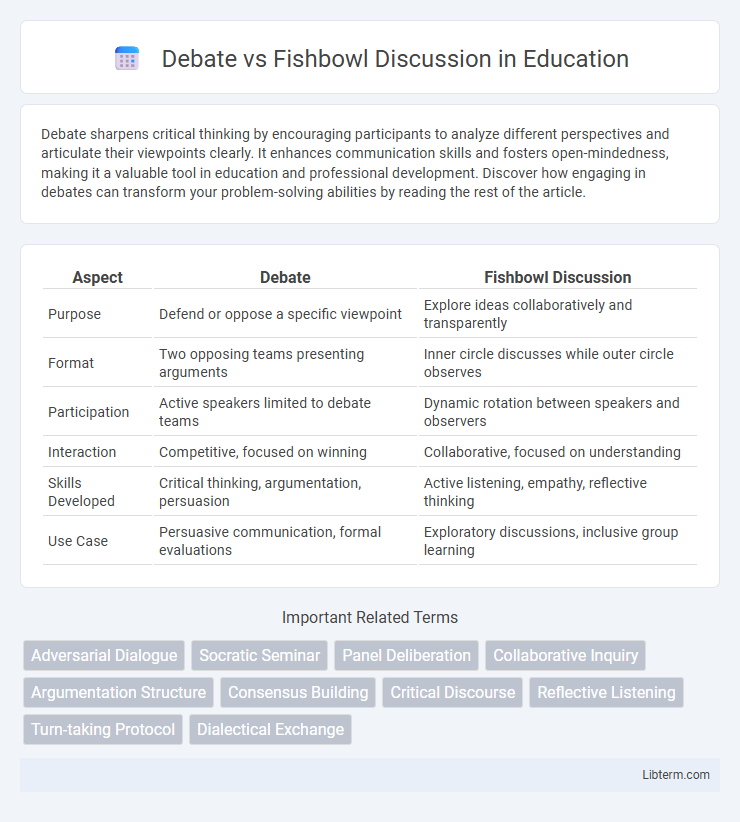Debate sharpens critical thinking by encouraging participants to analyze different perspectives and articulate their viewpoints clearly. It enhances communication skills and fosters open-mindedness, making it a valuable tool in education and professional development. Discover how engaging in debates can transform your problem-solving abilities by reading the rest of the article.
Table of Comparison
| Aspect | Debate | Fishbowl Discussion |
|---|---|---|
| Purpose | Defend or oppose a specific viewpoint | Explore ideas collaboratively and transparently |
| Format | Two opposing teams presenting arguments | Inner circle discusses while outer circle observes |
| Participation | Active speakers limited to debate teams | Dynamic rotation between speakers and observers |
| Interaction | Competitive, focused on winning | Collaborative, focused on understanding |
| Skills Developed | Critical thinking, argumentation, persuasion | Active listening, empathy, reflective thinking |
| Use Case | Persuasive communication, formal evaluations | Exploratory discussions, inclusive group learning |
Introduction to Debate and Fishbowl Discussion
Debate involves structured argumentation where participants present opposing viewpoints on a specific topic, aiming to persuade an audience or judges through evidence and rhetoric. Fishbowl discussion is an interactive format where a small group discusses a topic in the center of a larger audience, promoting inclusive dialogue and active listening. Both methods emphasize critical thinking but differ in participant engagement and communication style.
Defining Debate: Structure and Purpose
Debate is a formal discussion format where participants present opposing arguments based on evidence and logic, aiming to persuade an audience or judge. It typically involves structured speaking turns, time limits, and clear rules to ensure orderly exchange and focus on a resolution or proposition. The primary purpose of debate is to critically analyze issues, enhance argumentative skills, and determine the most convincing position through systematic reasoning.
What is a Fishbowl Discussion?
A Fishbowl Discussion is an interactive group conversation format where a small group of participants sit in a circle (the "fishbowl") and engage in dialogue while the larger group observes silently. This method encourages active listening, inclusive participation, and deeper exploration of ideas, contrasting with debates that focus on winning arguments. Fishbowl Discussions foster collaborative learning by allowing observers to swap places with discussants, enabling multiple perspectives within a structured environment.
Key Differences Between Debate and Fishbowl Methods
Debate emphasizes competitive argumentation where participants defend opposing viewpoints with the goal of persuasion, while fishbowl discussion fosters collaborative dialogue by allowing a small group to discuss topics in an inner circle as others listen. Debates are time-limited and structured with strict speaking turns, whereas fishbowls encourage open-ended interaction and active listening within rotating participants. The debate method prioritizes winning based on evidence and rhetoric, contrasting with the fishbowl approach that values shared understanding and inclusive participation.
Advantages of Debates in the Classroom
Debates in the classroom enhance critical thinking by encouraging students to construct and defend arguments with evidence while anticipating opposing viewpoints. This active engagement promotes public speaking skills, boosts confidence, and fosters a deeper understanding of complex topics through persuasive communication. Furthermore, debates stimulate analytical reasoning and help students develop the ability to evaluate multiple perspectives rigorously.
Benefits of Fishbowl Discussions for Engagement
Fishbowl discussions enhance participant engagement by fostering inclusive dialogue where every voice can be heard, creating a dynamic environment that encourages active listening and thoughtful responses. The rotating inner circle format reduces dominance by more vocal individuals, promoting equitable contribution and deeper understanding. This approach cultivates critical thinking and empathy, as participants are both observers and contributors, leading to richer, more collaborative learning experiences.
When to Use Debate vs. Fishbowl Techniques
Debate techniques are ideal when the goal is to explore opposing viewpoints in a structured, competitive format, encouraging critical thinking and persuasive argumentation. Fishbowl discussions excel in fostering inclusive dialogue and deep listening among participants, making them suitable for complex topics requiring collaborative reflection. Selecting between debate and fishbowl depends on whether the focus is on argument development or collective understanding.
Tips for Facilitating Effective Debates
Facilitating effective debates requires establishing clear rules, such as time limits for speaking and structured rebuttals, to maintain focus and fairness. Encouraging respectful dialogue and active listening helps participants engage thoughtfully and consider opposing perspectives. Providing pre-debate preparation materials and defining specific roles enhances participant confidence and the overall quality of the debate.
Strategies for Leading Productive Fishbowl Discussions
Effective strategies for leading productive fishbowl discussions include clearly defining participant roles and rotation schedules to maintain engagement and encourage diverse perspectives. Facilitators should establish ground rules promoting active listening, respectful dialogue, and equal participation, ensuring that all voices are heard without domination. Utilizing open-ended questions and summarizing key points helps maintain focus and deepens collective understanding throughout the discussion.
Conclusion: Choosing the Right Discussion Format
Selecting the appropriate discussion format depends on the objectives and desired outcomes of the conversation. Debate suits situations requiring clear, opposing viewpoints and decisive conclusions, while fishbowl discussions excel in fostering inclusive, reflective dialogue and collaborative understanding. Evaluating the goals for engagement, participant dynamics, and depth of exploration ensures the choice aligns with intended communicative effectiveness.
Debate Infographic

 libterm.com
libterm.com